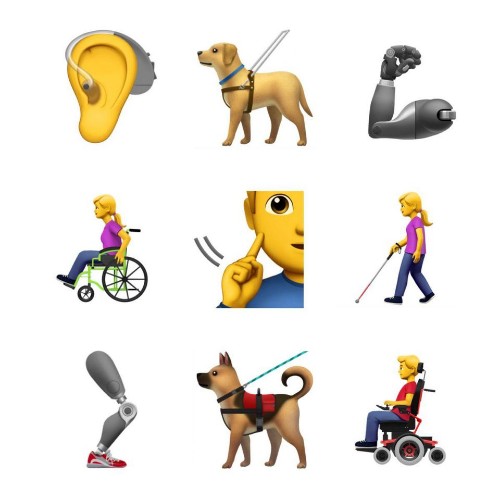Blog
-

Apple Proposes A New Line Of Accessibility Emoji
 30 Mar , 2018
30 Mar , 2018
Apple Proposes A New Line Of Accessibility Emoji
Apple recently outlined a new line of accessibility emoji in a proposal submitted to the Unicode Consortium. Some of the emoji characters that Apple proposed include a guide dog, people using canes and different types of wheelchairs, a hearing aid and prosthetic limbs. In the proposal, Apple said one in seven people have some form of disability and noted that this is not meant to be a comprehensive list of “possible depictions of disabilities,” but is an initial starting point for “greater representation for diversity within the emoji universe.”
Working in collaboration with community organizations like American Council of the Blind, the Cerebral Palsy Foundation and the National Association of the Deaf, Apple proposed a total of 13 new emoji when options for men and women are taken into account or 45 in total when also including options for skin tone, according to Emojipedia. “Apple is requesting the addition of emoji to better represent individuals with disabilities. Currently, emoji provide a wide range of options, but may not represent the experiences of those with disabilities,” said Apple in the opening line of the proposal.
Apple said it would be impossible to cover every possible use case with a limited set of characters. So for this proposal, Apple selected a set of emoji that are most inclusive to a large number of people in four main categories, which include Blind and Low Vision, Deaf and Hard of Hearing, Physical Motor and Hidden Disabilities.
Blind and Low Vision:
There are 285 million individuals who are blind or have low vision worldwide so Apple proposed a “guide dog with harness” and “person with white cane” (variants based on gender and skin tone).
Deaf and Hard of Hearing:
There are 360 million individuals who are deaf or hard of hearing. This is why Apple proposed adding two additional characters to better represent those with a range of hearing loss. This includes a “deaf sign” (variants based on gender and skin tone) and an “ear with hearing aid” (variants based on skin tone). The deaf sign features an index finger pointing to the cheek, which represents the “deaf sign” gesture in American Sign Language.
Physical and Motor Skills:
In the emoji universe, there are many ways to represent movement in various ways such as dancing, cartwheeling and surfing. To represent the movement of those with limited or augmented physical or motor skills, Apple suggested the addition of “person in mechanized wheelchair” (variants based on skin tone), “person in manual wheelchair” (variants based on skin tone) and “mechanical / prosthetic arm” (expected to have a variety of uses) and “mechanical / prosthetic leg” (expected to have a variety of uses).
The reason why Apple felt like it was necessary to have two separate characters in wheelchairs is because the type of assistive technology that is used by individuals is personal and mandated by their disability type. For example, someone who cannot self propel uses an electric wheelchair.
Hidden Disabilities:
For the Hidden Disabilities category, Apple proposed a “guide dog with harness.” For those who have hidden disabilities like Autism, anxiety, seizures and PTSD, service dogs can perform tasks to help partners live independent lives and may represent a “lifeline in moments of crisis.”
Microsoft has also been proactive about creating avatars to better represent people with disabilities. Next month, Microsoft is going to be rolling out a new line of Xbox Live Avatars which includes avatars with wheelchairs and prosthetic limbs. And Microsoft added a wider variation of costumes and accessories for Xbox Live Avatars. Plus users will be able to make their Xbox avatars pregnant. Microsoft previewed the new avatars last year:
Emojipedia said that the Unicode Technical Committee meeting will be taking place next month at Adobe’s headquarters in San Jose next month. And if approved, the accessibility emoji characters Apple proposed would be shortlisted to be potentially included in Emoji 12.0, due to be released in the first half of 2019. The 2018 emoji list was already approved last month and is expected to be rolled out in the second half of 2018.
Source: Forbes
Image credit: Apple’s accessibility emoji proposal, via Emojipedia





























































































































































































































































































































































































































































































































































































